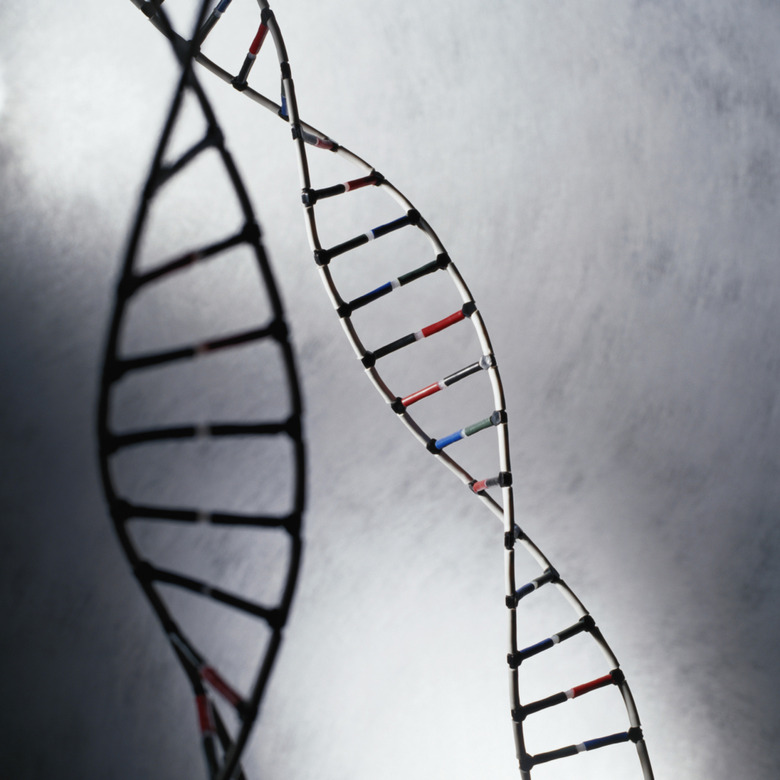What Is An Adaptive Advantage For Confining DNA In A Nucleus?
In prokaryotic cells such as bacteria, the organism's genetic material, or DNA (deoxyribonucleic acid), "floats" in the cell cytoplasm, separated from the outside world only by the outside barrier of the cell itself. In the cells of eukaryotes such as yourself, DNA is enclosed in a membrane-bound nucleus, offering a second layer of protection and improved focus of functionality.
Enclosing the genetic material of the cell within a protective double plasma membrane is an example of compartmentalization. That eukaryotic cells can so readily invoke this in their cell architecture is the major structural adaptation that has allowed eukaryotes to far outgrow prokaryotes in size and overall diversity.
Prokaryotic vs. Eukaryotic Cells
Prokaryotic vs. Eukaryotic Cells
All cells have four basic elements: a cell membrane on the outside, cytoplasm filling most of the inside, ribosomes for synthesizing proteins and genetic material in the form of DNA. Prokaryotes usually have little more than this, and all but a few consist of only a single one of these simple cells. What little DNA they have sits in a loose cluster in the cytoplasm.
Eukaryotic cells (i.e., those of animals, plants, protists and fungi) have all of the above inclusions and then some. Importantly, they contain membrane-bound organelles that carry out vital, repetitive functions, such as breaking down carbohydrate molecules fully.
Eukaryotic cells can differ markedly from each other both within and between organisms and species. All eukaryotes, for example, have mitochondria, but with a scant few exceptions, only plant cells have **chloroplasts.**
Why DNA in a Nucleus?
Why DNA in a Nucleus?
If asked to explain the advantages of compartmentalization in eukaryotic cells, you would have an easy task if equipped with basic knowledge about cell anatomy and physiology in general.
"Compartmentalization biology" is an evolutionary advance that has allowed cells to become specialized little machines (and in some cases whole organisms).
Eukaryotic cells have **membrane-bound organelles** for carrying out digestion, extracting energy from food and moving newly synthesized proteins from place to place. Lacking all of these, their prokaryotic counterparts can only grow to a certain size, and in most cases have not grown beyond being a single cell overall.
The massive size of the eukaryotic genome, reflected in its sheer amount of DNA, requires it to be packaged very tightly just to fit into a cell. Thus having a nucleus tightens up this aspect of eukaryotic cell construction considerably.
Membrane-Bound Organelles
Membrane-Bound Organelles
Some of the more prominent membrane-bound organelles in eukaryotic cells are:
**Mitochondria.** These are often called the "power plants" of cells, because it is here that the reactions of aerobic respiration occur. These reactions are responsible for the overwhelming amount of energy "creation" in eukaryotes.
**Chloroplasts.** Found in plant cells, chloroplasts use the power of sunlight to manufacture sugars from carbon dioxide gas in the environment.
**Lysosomes.** These are the "cleanup crew" of cells (see below).
**Endoplasmic reticulum.** This membranous "highway" moves newly made proteins from ribosomes to Golgi bodies and elsewhere.
**Golgi bodies.** These "sacs" move proteins about the cell between the endoplasmic reticulum and their ultimate destination.
Lysosomes and Digestion
Lysosomes and Digestion
Lysosomes carry digestive enzymes capable of breaking down cell waste, but also healthy cell components. So when these enzymes are made at the ribosomes, they must be moved to their eventual homes in lysosomes without damaging anything along the way.
These enzymes are transported in the cell in almost the same was as HAZMAT (hazardous waste materials) are transported along U.S. freeways and railways: Bearing special labels and with great care. Once in the high-acidity environment of the lysosomes, these acid hydrolase enzymes function very effectively.
Three examples of intracellular digestion by lysosomes:
- Carbohydrate, lipids, nucleic acids and proteins
- "Dead" organelles and their components
- Bacteria and other substances taken in from outside the cell
Cite This Article
MLA
Beck, Kevin. "What Is An Adaptive Advantage For Confining DNA In A Nucleus?" sciencing.com, https://www.sciencing.com/adaptive-advantage-confining-dna-nucleus-7274/. 18 June 2019.
APA
Beck, Kevin. (2019, June 18). What Is An Adaptive Advantage For Confining DNA In A Nucleus?. sciencing.com. Retrieved from https://www.sciencing.com/adaptive-advantage-confining-dna-nucleus-7274/
Chicago
Beck, Kevin. What Is An Adaptive Advantage For Confining DNA In A Nucleus? last modified March 24, 2022. https://www.sciencing.com/adaptive-advantage-confining-dna-nucleus-7274/
